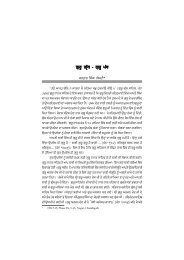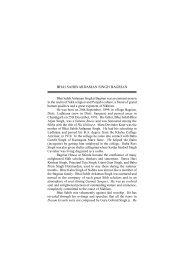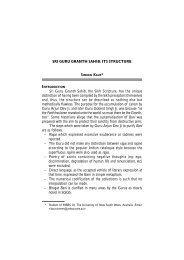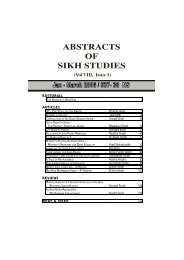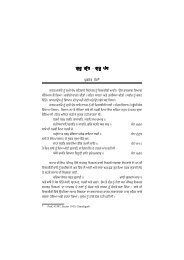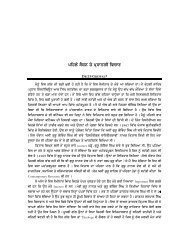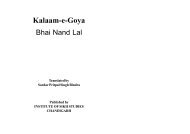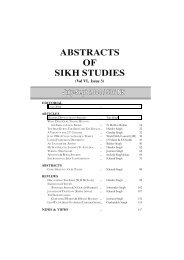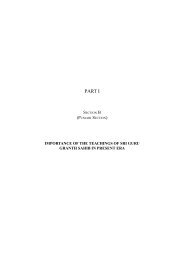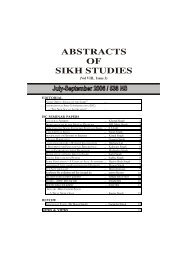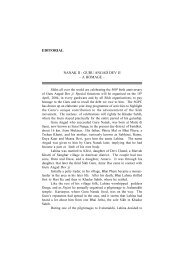editorial articles reviews news & views - Institute of Sikh Studies
editorial articles reviews news & views - Institute of Sikh Studies
editorial articles reviews news & views - Institute of Sikh Studies
You also want an ePaper? Increase the reach of your titles
YUMPU automatically turns print PDFs into web optimized ePapers that Google loves.
88<br />
ABSTRACTS OF SIKH STUDIES : APRIL-JUNE 2005 / 537 NS<br />
and ultimately Joseph Davy Cunningham (1849), after eight years <strong>of</strong> labour<br />
among the <strong>Sikh</strong>s. And, what he wrote about say, Bhai Taru Singh closely<br />
resembled Rattan Singh Bhangu’s Gurpanth Parkash, though he was not<br />
aware <strong>of</strong> it. It also means that oral tradition <strong>of</strong> which both Cunningham<br />
and Bhangu spoke, was extant during the 19th century. Herein lies the<br />
importance <strong>of</strong> Gianis, Kathakars and Dhadis.<br />
Fenech, however, attributes to Harjot Oberoi the insightful note<br />
that one man can rarely change the course <strong>of</strong> history, but without Ditt<br />
Singh the (Lahore Singh) Sabha might have been rather a different<br />
body. Further that, in the words <strong>of</strong> Fenech Ditt Singh felt that “the<br />
observance <strong>of</strong> caste, idolatry, priesthood, the veneration <strong>of</strong> gurus apart<br />
from the Guru Granth Sahib, and the worship <strong>of</strong> popular saints were<br />
charcteristics against which the <strong>Sikh</strong> Gurus had <strong>of</strong>ten spoken.” All<br />
these were designed to make the Khalsa once again assume the form<br />
it had possessed during its golden age, i.e., 1708-1765. Fenech talks<br />
<strong>of</strong> ‘Muslims persecution’ during the period, but he has s<strong>of</strong>t corner for<br />
‘Hindu chicanery’ <strong>of</strong> which he make no mention, whatsoever.<br />
Ditt Singh was aware <strong>of</strong> the wholesale extermination the Panth<br />
faced in 18th century, and the present danger <strong>of</strong> 19th century. The<br />
<strong>Sikh</strong>s were, however, now well placed before the “Arya Samaj and its<br />
Charismatic leaders. Another enemy they faced was arrogance and<br />
ignorance <strong>of</strong> the contemporary <strong>Sikh</strong>s. Tat Khalsa, <strong>of</strong> course, had to<br />
use martyr legend which predated Singh Sabha tradition and reinforced<br />
a strong commitment to faith in Adi Granth that emphasized the Tat<br />
Khalsa spirit.<br />
According to Ditt Singh it was baptismal water that become a<br />
potent elixir to make Khalsa overcome extreme hardship. He, therefore,<br />
compared the contemporary <strong>Sikh</strong>s to the past 18th century. The most<br />
important to Ditt Singh’s martyrologies was obviously the uncut hair<br />
(kes) as signified in Bhai Taru Singh’s martyrdom. He sought to instill<br />
in them dignity, to adopt Tat Khalsa standards. It was this rhetoric and<br />
the numerous handouts etc. that kept the <strong>Sikh</strong> tradition alive.<br />
The Khalsa Tract Society founded by Bhai Vir Singh in 1893<br />
followed with numerous publications. According to N G Barrier, by<br />
1911 a million copies issued by various organisations had been made



